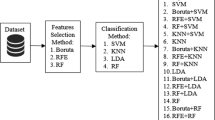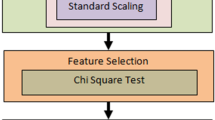Abstract
Recognition of medieval handwritten Gurmukhi manuscripts is an essential process for resourceful contents exploitation of the priceless information contained in them. There are numerous Gurmukhi script ancient manuscripts from fifteenth to twentieth century’s. In this paper, we have considered, work written by various persons from 18th to 20th centuries. For recognition, we have used various feature extraction techniques like zoning, discrete cosine transformations, and gradient features and different combinations of these features. For classification, four classifiers, namely, k-NN, SVM, Decision Tree, Random Forest individual and combinations of these four classifiers with voting scheme have been considered. Adaptive boosting and bagging have been explored for improving the recognition results and achieves the new state of the art for recognition of medieval handwritten Gurmukhi manuscripts recognition. Using this proposed framework, maximum recognition accuracy of 95.91% has been achieved using adaptive boosting technique and a combination of four different classifiers considered in this paper. To the best of our knowledge, this work is the successful attempt towards recognition of medieval handwritten Gurmukhi manuscripts and it can lead towards the development of optical character recognition systems for recognizing medieval handwritten documents in other Indic and non-Indic scripts as well.





Similar content being viewed by others
References
Plamondon R, Srihari SN (2000) On-line and off-line handwritten recognition: a comprehensive survey. IEEE Trans PAMI 22(1):63–84
Bortolozzi F, Britto Jr A, Oliveria LS and Morita M (2005) Recent advances in handwriting recognition, In: Proceedings of international workshop on document analysis (IWDA), pp 1–30
Lorigo LM, Govindaraju V (2006) Offline Arabic handwriting recognition: a survey. IEEE Trans PAMI 28(5):712–724
Nikolaos N, Dimitrios V (2008) A binarization algorithm for historical manuscripts, In: Proceedings of the 12th WSEAS international conference on communications, Heraklion, Greece, pp 41–51
Lehal GS (2001) Optical character recognition of machine printed Gurmukhi text. Ph.D. thesis, Punjabi University, Patiala, India
Lehal GS, Singh C (2006) A complete machine printed Gurmukhi OCR system. Vivek 16(3):10–17
Alirezaee S, Aghaeinia H, Faez K and Fard AS (2005) An efficient feature extraction method for the middle-age character recognition, In: Proceedings of the international conference on intelligent computing, pp 998–1006
Arrivault D, Richard N, Fernandez-Maloigne C, Bouyer P (2005) Collaboration between statistical and structural approaches for old handwritten characters recognition, In: Proceedings of graph-based representations in pattern recognition, pp 291–300
Feng SL, Manmatha R (2005) Classification models for historical manuscript recognition, In: Proceedings of international conference on document analysis and recognition (ICDAR-05), pp 528–532
Kumar M, Sharma RK, Jindal MK (2014) Efficient feature extraction techniques for offline handwritten Gurmukhi character recognition. Natl Acad Sci Lett 37(4):381–391
Kumar M, Jindal MK, Sharma RK (2014) A novel hierarchical techniques for offline handwritten Gurmukhi character recognition. Natl Acad Sci Lett 37(6):567–572
Cheriet M, Yacoubi ME, Fujisawa H, Lopresti D, Lorette G (2009) Handwriting recognition research: twenty years of achievement and beyond. Pattern Recognit 42(12):3131–3135
Shayegan MA, Aghabozorgi S, Raj RG (2014) A novel two-stage spectrum-based approach for dimensionality reduction: a case study on the recognition of handwritten numerals. J Appl Math 2014:1–15
Tian S, Bhattacharya U, Lu S, Su B, Wang Q, Wei X, Lu Y, Tan CL (2016) Multilingual scene character recognition with co-occurrence of histogram of oriented gradients. Pattern Recognit 51:125–134
Sarkhel R, Das N, Das A, Kundu M, Nasipuri M (2017) A multi-scale deep quad tree based feature extraction method for the recognition of isolated handwritten characters of popular indic scripts. Pattern Recognit 71:78–93
Mallikarjun H, Santosh KC, Pardeshi R (2013) Directional discrete cosine transforms for handwritten script identification, In: Proceedings of the 12th international conference on document analysis and recognition (ICDAR-13), pp 344–348
Ahmed H (2014) Handwritten digit recognition based on DCT features and SVM classifier, In: Proceedings of the 2nd world conference on complex systems (WCCS-14), pp 13–16
Aggarwal A, Rani R, Dhir R (2012) Recognition of Devanagari handwritten numerals using gradient features and SVM. Int J Comput Appl 48(8):39–44
Sharma DV, Lehal GS (2006) An iterative algorithm for segmentation of isolated handwritten words in Gurmukhi script, In: Proceedings of the 18th ICPR vol 2, pp 1022–1025
Freund Y, Schapire RE (1999) A short introduction to boosting. J Jpn Soc Artif Intell 14(5):771–780
Breiman L (1996) Bagging predictors. Mach Learn 24(2):123–140
Lehal GS, Singh C (1999) Feature extraction and classification for OCR of Gurmukhi script. Vivek 12(2):2–12
Sharma DV, Jain U (2010) Recognition of isolated handwritten Characters of Gurmukhi script using neocognitron. Int J Comput Appl 10(8):10–16
Kumar M, Jindal MK, Sharma RK (2011) k-Nearest neighbor based offline handwritten Gurmukhi character recognition, In: The proceedings of the international conference on image information processing, Jaypee University of Information Technology, Waknaghat (Shimla), pp 1–4
Kumar M, Sharma RK, Jindal MK (2013) A novel feature extraction technique for offline handwritten Gurmukhi character recognition. IETE J Res 59(6):687–692
Rani S (2016) Recognition of Gurmukhi handwritten manuscripts. Ph.D. thesis, Punjabi University, Patiala, India
Author information
Authors and Affiliations
Corresponding author
Ethics declarations
Conflict of interest
All authors declares that they have no conflict of interest.
Rights and permissions
About this article
Cite this article
Kumar, M., Jindal, S.R., Jindal, M.K. et al. Improved Recognition Results of Medieval Handwritten Gurmukhi Manuscripts Using Boosting and Bagging Methodologies. Neural Process Lett 50, 43–56 (2019). https://doi.org/10.1007/s11063-018-9913-6
Published:
Issue Date:
DOI: https://doi.org/10.1007/s11063-018-9913-6




